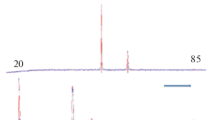Conclusions
-
1.
Even elongation, determining the ability of metals to change their shape, depends mainly on the rate of reduction of the relative hardening with increasing strain.
For martensitic steels, including high-carbon steels, which are not inferior to austenitic steels in terms of notch toughness (a n anda p) and ductility (ψ), the rate at which the relative elongation decreases in the process of deformation is far higher than for steels of the austenitic and transition classes, and therefore even elongation is substantially smaller.
-
2.
For martensitic and austenitic steels not undergoing phase transformations in the process of deformation an increase or decrease of deformation temperature leads respectively to a decrease or increase of relative hardening, and thus even elongation.
-
3.
With formation of 20–30% martensite in unstable austenitic steels in the process of deformation the rate at which the relative hardening decreases during deformation is lower than for stable austenitic steels, and the even elongation reaches a peak.
For each steel undergoing the γ→α transformation there is an optimal temperature (for a given strain rate) at which even elongation is highest.
-
4.
The stability of austenite in stainless steels can be determined for practical purposes from the chromium equivalent of martensite formation (Cr Meqv ) [6].
-
5.
Practically complete elimination of carbon and nitrogen sharply reduces the even elongation of martensitic steels but has no effect on the even elongation of austenitic steels. The even elongation of martensitic steels increases considerably after tempering at 200°.
Similar content being viewed by others
Literature cited
Ya. B. Fridman, Mechanical Properties of Metals [in Russian], Oborongiz, Moscow (1952), p. 137.
A. Nadai, Ductility and Fracture of Solids [Russian translation] G. S. Shapiro (editor), IL, Moscow (1954), p. 463.
Ya. S. Moroz, ,“Ductile characteristics of alloys reflecting some aspects of the physical condition,” Zh. Tekh. Fiz.,24, No. 3, 425 (1954).
P. O. Pashkov, Ductility and Fracture of Metals [in Russian], Sudpromgiz, Leningrad (1950), p. 80.
N. P. Dmitriev et al., ,“Correlation between even deformation and the hardening coefficient,” Fiz. Met. Metalloved.,34, No. 3, 595 (1972).
Ya. M. Potak and E. A. Sagalevich, ,“Structural diagram of wrought stainless steels,” Metalloved. Term. Obrab. Met., No. 9, 12 (1971).
A. P. Gulyaev, S. V. Lepnev, and Ya. M. Potak, ,“High-strength austenitic steels,” Metalloved. Term. Obrab. Met., No. 1, 10 (1959).
Additional information
Translated from Metallovedenie i Termicheskaya Obrabotka Metallov, No. 6, pp. 49–54, June, 1977.
Rights and permissions
About this article
Cite this article
Pokrovskaya, N.G., Potak, Y.M. Even elongation of stainless steels. Met Sci Heat Treat 19, 473–477 (1977). https://doi.org/10.1007/BF00713086
Issue Date:
DOI: https://doi.org/10.1007/BF00713086




